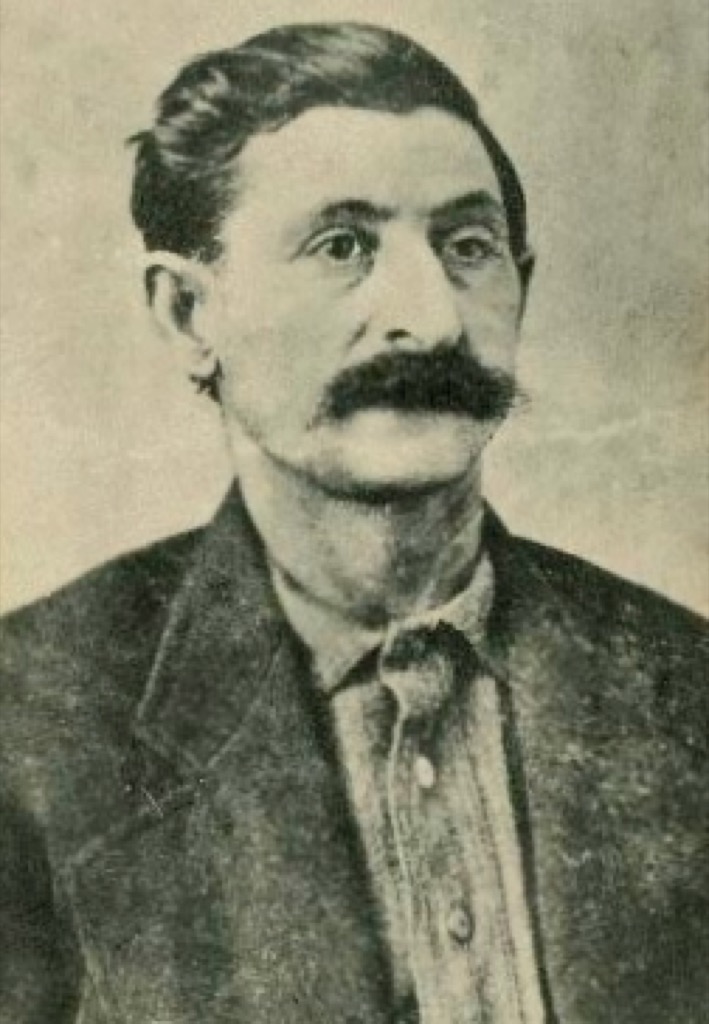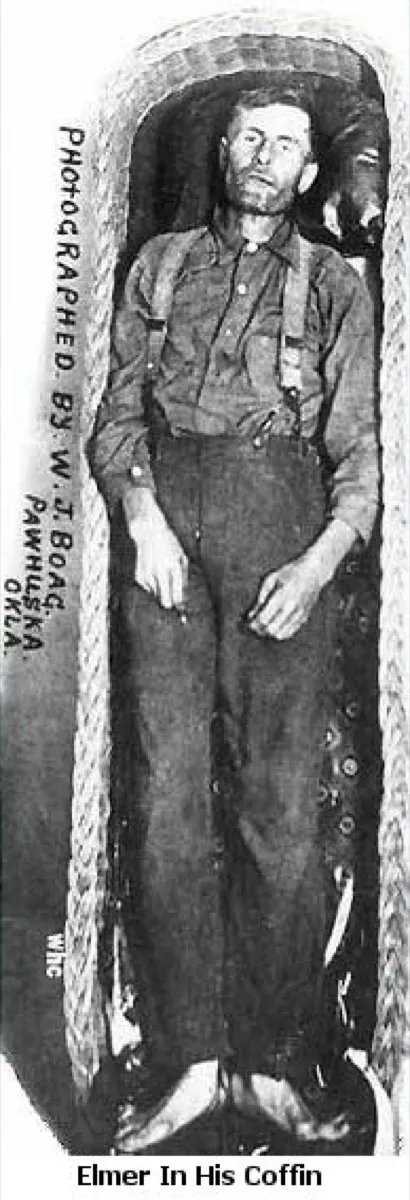With that in mind, we’ve rounded up some of the country’s most curious myths that can be pinned down to factual events—from tales of the bogeymen and subterranean cities to the story of the word the dictionary got wrong. So read on, and prepare to be astounded by these urban legends that are completely verifiable. After all, even the wildest tales are rumored to have a grain of truth to them, right? The tale of Charlie No-Face is an example of one of those true stories that gets wildly twisted in each retelling. Here are the facts: In the early 1900s, a Pennsylvania boy named Ray Robinson was electrocuted by a trolley wire, resulting in lifelong disfigurement—specifically, most of his facial features melted away. After that, he was ostracized and stories about his disfigurement grew more and more preposterous as the rumor mill began to spin. Today, the people of western Pennsylvania insist that Charlie No-Face—whose nickname remains a mystery—has become a radioactive, glowing Green Man-type figure who haunts an abandoned freight tunnel. But the truth is that he was just a guy who experienced an unfortunate childhood accident. Passersby are often keen to point out the oddly-shaped mark, resembling a leg, that stains the tomb of this former Justice of the Peace. That’s because rumor has it that Colonel Jonathan Buck ordered a young woman be put to death for practicing witchcraft. Allegedly, her leg rolled out of the fiery blaze, and, in retaliation, the witch put an eternal curse on Buck’s final resting place in Bucksport, Maine. While we can’t confirm any of that, of course, the tombstone has reportedly been scrubbed thoroughly several times, but the leg-shaped stain continues to reappear. Today, it’s become somewhat of a tourist attraction.
It just depends on what century we’re talking about, here. In the early 1900s, it wasn’t unheard of for wealthy New Yorkers to bring baby Floridian alligators back to the Big Apple to keep as pets. When they decided their pets weren’t quite as cute as they’d hoped, they supposedly flushed them down the toilet. In 1932, the New York Times repo rt ed that a group of teenagers had witnessed a gator easing itself out of the Bronx River. But don’t fret—the chances that there’s a band of toothy reptiles currently swimming through the sewage of your city these days is nil.
That pivotal moment for all of humanity, when Americans became the first people to step foot on the moon? Yeah, of course that was scripted. But the quotation that we all know and love is not what astronaut Neil Armstrong was supposed to radio back to Earth. We all know the phrase as, “One small step for man, one giant leap for mankind.” But he was meant to say, “One small step for a man, one giant leap for mankind.” Apparently, after listening to the recording of himself, Armstrong admitted to misspeaking the line. Kind of. In the flurry of testing after World War II, after the U.S. had dropped the world’s first atomic bomb, scientists wanted to determine the effect of nuclear radiation on human flesh. In a series of tests known as “Project Sunshine,” the test subjects were deceased children — specifically, stillborn babies, whose parents were probably not notified about how their children’s bodies were being experimented on. Gruesome and sad, but true. You know how sometimes the water at your hotel just tastes downright disgusting? Well, it’s not entirely outside of the realm of reason that there might be a dead body floating in the water supply, contributing to the less than desirable taste. At least, that’s what happened at a Los Angeles hotel in 2013. After several days of guests complaining about a terrible smell that emanated anytime they turned on the shower—not to mention the terrible taste when they tried to brush their teeth—management checked the water tank on the hotel roof and found the body of 21-year-old Elisa Lam floating inside. Her body was estimated to have been in the tank for two weeks.
The 1992 horror film Candyman includes a scene in which the main characters learn that a murderer might be entering apartments via the medicine cabinets—and apparently, this was once a legitimate structural flaw in some apartment complexes. The medicine cabinets in adjoining apartments in Chicago were connected by a flimsy partition, and an actual murder was committed by criminals entering through this weak structure. And for more crazy real-life events, check out History’s Biggest Conspiracy Theories That Still Creep Us Out. Right after a family purchased their dream home in New Jersey in 2014, a stalker calling himself “The Watcher” barraged them with a series of letters, claiming, among other things, that his own family has “watched” the house for generations. The letters also inquired about when the family would be filling the house with “young blood.” While it’s unclear if there’s any truth to what was substantiated in the letters, it was enough to scare the parents and their three young children out of moving into the house.
Parents often reassure their children that the Bogeyman doesn’t exist, but on Staten Island in the 1980s, he was all too real. “Cropsey” would drag children from their beds; carrying a bloody ax in the crook of his arm. In reality, the legends surrounding Cropsey can likely all be traced back to a man by the name of Andre Rand. Rand worked as a janitor at Willowbrook State School, which specialized in providing services for children with disabilities. He was later suspected of kidnapping multiple children and officially found guilty for kidnapping two. Though the conspiracy theories about the subterranean city beneath Denver International Airport have been thoroughly debunked, another of America’s cities (Las Vegas) does have its own underground city—but it’s less of a conspiracy and more of an effort on the part of the tourist industry to maintain the city’s “appeal.” With police’s stringent limitations preventing homeless people from setting up camp on the Vegas strip, that population struggled to find anywhere to go and ended up in the city’s underground flood channels. Resting in the murky depths of Connecticut’s Gardner Lake is a fully intact house; that much is confirmed—by the Hartford Courant , no less. Supposedly, the house sank beneath the surface when a family attempted to move it across the frozen lake in the midst of a 19th century winter. The really eerie part is that, to this day, fishermen report hearing strained musical notes gurgling up to the surface of the lake, supposedly from the parlor room piano. (Whether or not that part of the story is true, though, we’re in no position to say.)
It’s no Atlantis, but it’s probably as close as America is going to get to the Underwater City of myth. In the 1940s, an entire (evacuated) town in Georgia was purposefully flooded with water in order to build what is now known as Lake Lanier. The entire community, including a racetrack, was submerged by the lake-building project.
Apparently, a letter to the editor of the Journal of the American Medical Association in 1982 documented how a medical school student had recently recognized her own great aunt among the cadavers being dissected in one of her classes. Luckily, this situation doesn’t seem to happen very frequently.
The situation isn’t quite as horror-movie scary as its name implies. In 2014, a woman dressed in black from head to toe, including a trailing black veil and billowing black robes, was spotted walking the highways of the South, and a series of rumors mounted about what she could possibly be up to. The truth was that the woman, a U.S. Army veteran, described the self-imposed pilgrimage as having to do with her faith and religion. George Parrot, also known as Big Nose George, was hanged in the 1880s for being a raucous outlaw with a penchant for horse thievery. Supposedly, a physician was assigned to study George’s brain in order to root out the cause of his criminal activity. And bizarrely, he decided to use George’s skin for a number of crude purposes—including making himself a new pair of shoes. Today, the shoes are on display at the Carbon County Museum in Montana.ae0fcc31ae342fd3a1346ebb1f342fcb Be honest, you’ve probably always harbored a bit of a secret fear of what could possibly be lurking in the toilet as you lower yourself on the seat, right? And if you haven’t, you might start looking before you sit yourself down now. As told on an episode of NPR’s This American Life , an Oregon man returned from a fun night out and wanted to make a quick trip to the bathroom before crawling into bed—but that plan was foiled by a furry live rodent he found in the toilet when he lifted up the lid!
It’s recommended that parents exercise some caution and check their children’s candy after an evening of trick-or-treating—and for good reason. There have unfortunately been multiple reports of unsuspecting children returning home with small baggies of crystal methamphetamine in their treat bags.
Ever wondered if the medicine you’re dutifully taking as prescribed includes any extra ingredients? Thanks to the modern-day tamper-resistant seal, you can rest assured that your medicine is mixed just like the doctor ordered. Unfortunately, this packaging was developed for a reason. In 1982, someone got it into their head to inject potassium cyanide (a deadly poison) into multiple bottles of Tylenol. After several people died in what came to be known as the Tylenol Murders , the Federal Drug Administration stepped up to the plate and came out with regulations requiring all medicinal manufacturers to produce seals that were tamper-proof. Yes, the soda company everyone knows and loves has experienced its fair share of public relations problems. The poster in question was benign enough, at least in the company’s intention. Issued in the 1980s as a way to promote the new bottle design, the poster bearing the slogan “Feel the Curves!” was quickly recalled after a keen-eyed observer noted an inappropriate sexual image in one of the ice cubes.
From 1934 through 1947, Merriam-Webster inadvertently included an entry for a fabricated word: “dord,” defined as “density.” The error was eventually corrected by a flustered editor, who termed it a " ghost word ." It’s nice to know that one of the most authoritative sources on the English language makes mistakes, too. These squirrels’ possible possession of arcane powers (akin to black cats on Halloween) remain a source of contention, but the existence of these rare, jet black woodland creatures is irrefutable. These black squirrels are confined to the Midwest, concentrated in particularly large clusters in Michigan. The story goes that Kellogg’s cereal guru W.K. Kellogg imported the black squirrels in an effort to eradicate red squirrels, a species that he detested.
So maybe it’s not exactly possible for your shoelace to get caught in the escalator and suck you completely underneath the machine—admit it, you did have that fear as a kid. But escalators are more dangerous than you might expect. A study published in the journal West Jem in 2013 reported that the U.S. experiences approximately 10,000 emergency-level escalator-related injuries each year. Unsurprisingly, alcohol usually plays a large role in those accidents. So when you’ve had a few, consider opting for the nearest elevator instead. Though it existed as an urban legend for some time, this story of a lawyer falling through a window to prove just how “unbreakable” the glass was in the Toronto-Dominion Centre is indeed true. As told by Torontoist, in July 1993, Garry Hoy, a partner at the law firm of Holden, Day, Wilson, was attempting to prove how strong the glass was in the building (pictured above) to a group of articled students. However, when he lunged at the window using his full weight, the entire window popped out of the frame, sending Hoy 24 stories to his death. The glass didn’t technically shatter, but Hoy was incorrect with the claim that it could withstand the weight of a 160-pound man.
While the balloon-buoyed flying lawn chair is a common trope in cartoons, it has roots in reality, too! The first person to create a flying lawn chair was Larry Walters, who made a homemade airship using a lawn chair and 45 helium-filled weather balloons. He set out with this homemade flying vehicle on July 2, 1982, out of San Pedro, California, and flew through the sky for a whole 45 minutes before becoming entangled in power lines and climbing down to safety, according to the New Yorker. Since his semi-successful flight, numerous imitators have surfaced, attempting to recreate this historic moment—and all have had the same amount of non-success.
Though it may read like an urban legend, the corpse of Elmer McCurdy, an early 20th century bank and train robber, somehow became a frightening staple of the traveling carnival and sideshow circuit for more than five decades. That was, until his mummified remains, then used as a frightful prop, were discovered in 1976 at The Pike amusement zone in Long Beach, California. Now dubbed “The Bandit Who Wouldn’t Give Up,” McCurdy’s remains were finally sent to their final resting place in 1977, at the Summit View Cemetery in Guthrie, Oklahoma.
If you were ever a resident of Council Grove, Kansas, it’s likely that you’re familiar with an urban legend that details the accidental exploits of a town sheriff who made a pre-internet era viral erotic tape. As it turns out, the legend actually checks out. As reported by ABC News, the sheriff of Council Grove, Kansas, accidentally returned a VHS—containing intimate footage of him and his wife—to the local video rental store. After the slip-up was made, numerous people around town soon learned the most intimate details of their local sheriff’s life. Oops! Legend has it that some people encounter dead bodies underneath their hotel beds. Though it sounds like a childhood campfire story, in fact, a dozen-plus newspapers have detailed stories about this grisly occurrence—from a couple in Atlantic City sleeping on a mattress that contained a dead body to guests at the Budget Motel in Memphis finding the dead body of Sony Millbrook, a missing person, just beneath their bed. For 27 years straight, citizens and tourists in the North Pond region of Maine would come home to mysteriously find possessions—food, clothing, tools, toiletries—missing. And an urban legend was borne: There was a hermit in the woods. Then, in 2013, legend became fact when one man, Christopher Knight, was arrested and booked on robbery charges. According to GQ, he committed more than three dozen robberies per year. As for how investigators tied him to three decades of crime? When Knight was asked “how long” he’d been living in the woods, he paused and retorted by asking when the Chernobyl meltdown occurred. (The answer is 1986.)
Despite the tall tales that are perpetually swirling about Nevada’s Area 51, the only extraterrestrial presence in the Southwest that we can positively confirm is the mass “burial ground” for the 1982 E.T. video game, E.T. The Extraterrestrial . The video game, which was based on the seminal 1982 Disney film of the same name, was met with such widespread admonition that Atari decided to literally bury all the unsold games in the sands of a New Mexico landfill. Dramatic much? Even if you weren’t a resident of Virginia in the 1970s when this urban legend became a favorite tale among children and teens, it’s likely that you’re at least familiar with some aspects of the story. As the legend goes, an escaped mental institution patient had taken to roaming around the countryside of Virginia, killing rabbits and hanging their dead bodies from bridges in the area. And, though this exact story may not fully check out, there are very real reports of a raving mad man in the area, who was seen by numerous people in October 1970. According to the witnesses, he was dressed in a white suit and bunny ears, sometimes even launching a hatchet at cars full of people. And for more bizarre trivia, check out The Most Hard-to-Believe Fact About Every State. To discover more amazing secrets about living your best life, click here to follow us on Instagram!












